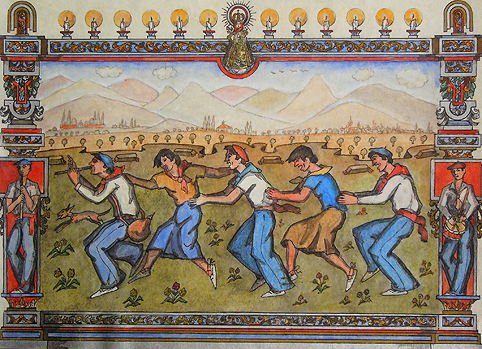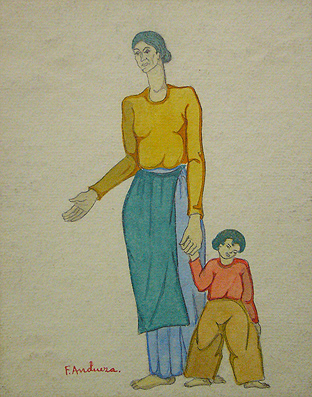The piece of the month of June 2007
TWO DRAWINGS BY FLORENTINO ANDUEZA ALFARO: FIESTA AND SOCIAL REALISM
Ignacio J. Urricelqui Pacho
Chair of Navarrese Heritage and Art
The following lines wish to bring to the present the report of an interesting but little known artist from Navarre who, for various circumstances, was closely linked for years to Fitero. The covers of the 1949 and 1952 festival programs are testimony to this, as well as his drawings and, of course, the memory of many people. We are talking about Florentino Andueza Alfaro.
Born in Tafalla in 1899, he began to study at the San Fernando School of Fine Arts in the 1923-1924 academic year, with a grant from the Diputación de Navarra, remaining enrolled until 1926. In the capital he had the opportunity to be intimate with the Zubiaurre brothers, with whom he was united, in addition to the passion for painting, the loss of hearing since he was one year old. At the Madrid academy he stood out for his aptitudes, obtaining in 1925 and 1926 the award in the competitive examinations held among the most outstanding students. In September 1928, after finishing his training, Diario de Navarra reported that the artist had arrived in Fitero, coming from Madrid, with the intention of going to France, Germany and Belgium. He thus became one of the few Navarrese artists of his generation with such a broad formative pathway , only comparable to that of other more veteran artists such as Inocencio García Asarta, Javier Ciga or Jesús Basiano.
He exhibited in 1920 at the Círculo de Bellas Artes in Madrid and, apparently, in Paris (1925, 1926 and 1928), in Brussels (1930), and at the Palacio de la Prensa in Madrid (1940). In 1930, he received a travel grant of 500 pesetas in the sculpture section of the National Fine Arts exhibition . In 1939 he joined the Madrid Art Workshops as professor , position where he remained until his retirement in 1967. Tafallés by birth and adopted son of Fitero, he lived between this Navarrese town and Madrid, developing an important work of commitment with the association de Sordomudos, where he exhibited on different occasions. He died in the Spanish capital on December 28, 1988, at the age of 89. His funeral was held on January 18 in the church of San Fermín de los Navarros, at 6:00 p.m. average .
Painter, sculptor, draftsman and watercolorist, he endowed his works with a deep folkloric and anecdotal character, not Exempt of caricaturization and expressionist sense and, sometimes, of certain dramatism and social content. The relationship with the Zubiaurre brothers oriented his preferences towards rural folklore, the representation of types, uses and customs of the rural environment and, in particular, of the riverside, although other influences should not be neglected, such as that of José Arrúe, a fine draftsman of Basque customs, although more ironic than the Navarrese.

Dance scene in the surroundings of Fitero
Themes such as the work, the family, the daily effort, or the party are treated by Andueza in numerous drawings of beautiful invoice and great decorativism, thought as whims in which the author delights in the stroke and in the use of watercolor chromaticism. One of the images published (Fig. 1), related to others of similar composition and treatment, sample to a group of five figures, three male and two female, alternating successively, dancing in a meadow holding shoulders and waists, in which it is clear the costumbrista and even ethnicist nuance. The leading man plays a flute -in other drawings it is the bagpipe- leading the dance and carries a wineskin on his shoulder. The men wear white espadrilles and wear blue pants, white blouse, neckerchief and a beret on their heads. The scarves and berets alternate their colors, red and blue for the first one, blue and red for the second one, in the middle of the composition, and again red and blue for the one that closes the line. Both this one and the previous one also wear a red sash, a detail that the first one lacks. The two women also participate in this alternation of colors. Both wear skirts, blouses and neckerchiefs. In the first woman, second in the row, the skirt is blue and the blouse is orange, while in the second woman, fourth in the row, the skirt is orange and the blouse is blue. Meanwhile, the scarf of the first woman is red and that of the second one is of similar tones to the skirt. With this alternation of colors an attractive visual game is achieved and a dynamism that contributes to the dynamism of the dancing figures. The scene represents a festive and friendly atmosphere, emphasized by the wide meadow that develops around them, covered with flowers, as well as a little dog running smiling beside them. In the background, as a spatial reference, Andueza incorporates a recreation of Fitero and its surroundings, with the cemetery on the left, the humilladero in the center and, on the right, the town with the farmhouse and the unmistakable silhouette of the monastery. The mountains and the sky, of pleasant tonality, contribute to this bucolic atmosphere. The nib drawing is clean, without excessive nuances, very close to the graphic language that characterizes his other works, while the watercolor color is in charge of shading the contours and the setting of the environment. The scene is framed by an overloaded composition, in reds and blues of attractive combination, with vegetal and figurative motifs -two musicians as stipites, one playing the txun txun and the other the tambourine-, and, in the upper part, an exaltation of the Virgen de la Barda surrounded by lighted candles, six on each side. Other watercolor drawings similar to this one insist on the festive and friendly atmosphere, incorporating placid cows grazing in the meadows and fireworks illuminating the Fiteran sky.
However, on occasion, Andueza's gaze turns to themes of greater social commitment. The experience of the civil war and the post-war period left their mark on him in some drawings in which, beyond their traditional flavor, he emphasizes the lack and need of some people. One of these drawings, which we present here (Fig. 02), depicts a mother standing barefoot, dressed in a long blue skirt, green apron and orange blouse, that is, colors of strong visual impact. The figure appears disproportionate, with long arms, wide hands -one of which, the right one, is extended asking for the people's charity-, elongated neck and restrained and circumspect gesture. With her tremendous left hand she grasps the tiny hand of her son, also barefoot, wearing orange pants and a red T-shirt. The simplicity in the stroke highlights the visual effectiveness of the image and its nuanced dramatism, in which the imprint of Spanish masters of the 20th century, such as Julio González, Pablo Ruiz Picasso, Rafael Zabaleta and even Francis Bartolozzi and his remarkable drawings of the civil war, can be seen.

Mother and child
Many other drawings could be described, such as the series dedicated to the game of ski lift, all of them of similar invoice to these that we comment and that show a prolific production. In September 2006 some of his works were exhibited in the Patio de Gigantes of the City Hall of Pamplona, in a sample organized by the association of Deaf and Dumb People of Navarra. All in all, we must be satisfied with what has been said, while waiting for a more detailed study to shed light on the obscure figure of this interesting author, worthy of being included in the list of Navarrese artists.
bibliography AND HEMEROGRAPHY
Diario de Navarra, July 10, 1925; June 13, 1926; September 18, 1928; March 25, 1977.
"Florentino Andueza Alfaro", in Foro del silencio, nº 0, 1977, pp. 37-38.
PANTORBA, Bernardino de, Historia y crítica de las Exposiciones Nacionales de Bellas Artes celebradas en España, Jesús Ramón Garcia - Rama J., 1980.
